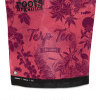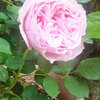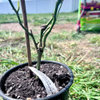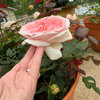The Lesser Of Two Evils (fungicides) For Black Spot
SoFL Rose z10
10 years ago
Featured Answer
Sort by:Oldest
Comments (62)
SoFL Rose z10
10 years agolast modified: 9 years agoken-n.ga.mts
10 years agolast modified: 9 years agoRelated Discussions
Which lesser of two evils?
Comments (10)Losta ways to grow starter plants. I have a variety of things going including tomatoes, peppers, herbs, artichokes and hummingbird flowers. I started mine in mid Feb. For pots I use 12 oz. stryofoam cups filled w/ metro mix 360. All the pots(70+) are in a shallow clear "sweater" tote box (with a clear lid to start). The tote boxes are portable & make bottom watering easy. They are under flourescent t8 lights 24/7 with a fan on 12 hr/day. Everything looks great and the tomatoes have thick stems. I like to have good sized plants to put in the ground asap. I plant my peppers deep and tomatoes extra deep. Also, I like to put a few "experimental" plants out early with a Wall o' Water. Last year they made it through some late snow...I just got a variety of black tomato seeds from a GW member a few weeks ago, so those are putting out their first set of true leaves now. Next year I will get an earlier start on them... My advice: I would start them now. As mentioned by others, you won't need light or more water for the first week. Just keep them covered. Temperature is the key....See MoreAnyone know how to control leaf spot? fungicide?
Comments (4)Your welcome. Also it looks like one of my baby windmill palms has it too (its potted). I dont really pay attention to it so I didnt notice it as anything bad. It actually developed a year ago, but the palm is still growing well and the new fronds have no sign leaf spot. I also have it a little on my areca palm. They usually get it from the nursuries because palm "bugs" are not really common in a zone 7 because of a lack of palms (sadly, about the lack of palms, not the fungus). Good new is that the fungus is rarely fatal. I heard that copper based fungicide helps and also keeping the leaves as dry as possible. The growth with the fungus on it will not improve, but treatment should prevent it from spreading. Try to keep the palm dry because any rainfall should take care of watering. If you are getting alot of rain then you might have to find away of keeping it dry. I water mine when the soil gets dry which is usually 1 time a week if its really sunny and moderately warm. Good luck!...See MoreLesser of two evils
Comments (26)You have an older home which has been extensively updated in a community with a shortage of suitable homes. So, I would not spend too much time worrying about the future market value of changes you will make to the home. When quality housing is in short supply, buyers will accept less than ideal layouts just to find something updated with decent construction Our bathroom is between the master bedroom and the hallway, with a door each side. Occasionally someone will forget to unlock the bedroom door and I have to wake up enough to go through the room, down the hallway and around the corner...not a happy mama at that point! I could see children being deliberately obnoxious to a sibling and "forgetting" to unlock the door to a shared bathroom My choice would probably be add a full bathroom en-suite to the main floor bedroom. That would increase the desirability of your house as a main floor bedroom and bath is a positive for people looking at aging in place....See MoreGreencure fungicide.....Two (2), Questions?
Comments (2)Moses, I'm not sure anything would work with the amount of rain and humidity we get near the end of the season. However, this year i did spray with a couple of things and it helped tremendously. In early spring, I used horticultural oil and then BSoda, then sulphur and switching between the two whenever I remembered. I use a natural soap with them to help it adhere to the leaves. I also mix the sulphur with some vinegar as my local rose chapter specialist advised doing that. I'm sure that helps with the ph as well. 1 tbs per Gal. I didn't have BSpot until I stopped, but I'm lazy and it's late in the season. I was actually surprised how well it worked as I had sprayed with one of the store-bought chemicals before and it didn't really work any better. I think greencure is P.chloride?. I truly feel the oil helped as it kills the BS spores on the canes. I also took off all the leaves. The problem with this rain is I'd be spraying everyday and my roses are too spread out for that. It doesn't take much time to do it, though. Most of my roses are pretty BS resistant, but even they will succomb by now. I'm mainly trying to keep BS to a low roar on those that are prone to BS, but I still want to keep. Keeping everything well fertilized also helped I think....See Morekentucky_rose zone 6
10 years agolast modified: 9 years agobuford
10 years agolast modified: 9 years agobuford
10 years agolast modified: 9 years agohenry_kuska
10 years agolast modified: 9 years agodizzylizzy 7b
10 years agolast modified: 9 years agodizzylizzy 7b
10 years agolast modified: 9 years agoMaude80
10 years agolast modified: 9 years agoMaude80
10 years agolast modified: 9 years agoidixierose
10 years agolast modified: 9 years agonikthegreek
10 years agolast modified: 9 years agodublinbay z6 (KS)
10 years agolast modified: 9 years agothe_bustopher z6 MO
10 years agolast modified: 9 years agonikthegreek
10 years agolast modified: 9 years agobuford
10 years agolast modified: 9 years agolori_elf z6b MD
10 years agolast modified: 9 years agodiane_nj 6b/7a
10 years agolast modified: 9 years agodublinbay z6 (KS)
10 years agolast modified: 9 years agobuford
10 years agolast modified: 9 years agoken-n.ga.mts
10 years agolast modified: 9 years agoUser
10 years agolast modified: 9 years agonikthegreek
10 years agolast modified: 9 years agoken-n.ga.mts
10 years agolast modified: 9 years agohenry_kuska
10 years agolast modified: 9 years agonikthegreek
10 years agolast modified: 9 years agonikthegreek
10 years agolast modified: 9 years agoEmbothrium
10 years agolast modified: 9 years agobuford
10 years agolast modified: 9 years agohenry_kuska
10 years agolast modified: 9 years agoken-n.ga.mts
10 years agolast modified: 9 years agobart_2010
10 years agolast modified: 9 years agobuford
10 years agolast modified: 9 years agoUser
10 years agolast modified: 9 years agoUser
10 years agolast modified: 9 years agoZyperiris
10 years agolast modified: 9 years agosaldut
10 years agolast modified: 9 years agodublinbay z6 (KS)
10 years agolast modified: 9 years agoZyperiris
10 years agolast modified: 9 years agojjstatz
10 years agolast modified: 9 years agoSoFL Rose z10
10 years agolast modified: 9 years agojjstatz
10 years agolast modified: 9 years agojulie1944
9 years agolast modified: 9 years agovasue VA
9 years agolast modified: 9 years agosandandsun
9 years agolast modified: 9 years agonickjoseph Milwaukee, WI
9 years agolast modified: 9 years agocarla17
9 years agolast modified: 9 years agobuford
9 years agolast modified: 9 years agoDeni RN
3 years ago
Related Stories

FLOWERSRudbeckia Mania: Go Beyond Black-Eyed Susan in the Garden
Branch out from typical nursery fare, with lesser-known Rudbeckia species that have delightfully unexpected features
Full Story
KITCHEN DESIGN10 Smashing Black Kitchens
Looking for something different from an all-white kitchen? Think about going stylishly dark instead
Full Story
Houzz Call: What Gives You the Creeps at Home?
Halloween horror got nothing on your basement, attic or closet? Show us that scary spot you steer clear of
Full Story
GARDENING GUIDESDo You Have This Invasive Plant in Your Yard?
Garlic mustard is spreading across the U.S. Here’s how to spot it and what to do
Full Story
FIREPLACESInglenooks Carry On a Warm Tradition
Designs for these benches by the fire have evolved, but the spots offer the same warmth as always
Full Story
PAINTINGWhat to Know About Milk Paint and Chalk Paint — and How to Use Them
Learn the pros, cons, cost and more for these two easy-to-use paints that are great for giving furniture a vintage look
Full Story
ARCHITECTUREModern or Contemporary Architecture? The Interiors Edition
See how one expert distinguishes between two popular camps of interior architecture. Do you agree with his choices?
Full Story
GARDENING GUIDESTree Care: Common Tree Diseases and What to Do About Them
Learn to recognize trees that may be affected by diseases or pests so you can quickly take action
Full Story
GARDENING GUIDESBackyard Birds: How to Care for American Goldfinches
The American goldfinch is a bright-in-the-summer visitor and one of the only vegetarian songbirds. Here's how to give them a healthy habitat
Full Story
GARDENING GUIDES6 Wonderfully Easy Roses for Any Gardener
Look like an expert even if you're just starting out, with these low-maintenance gems of the rose world
Full Story






User